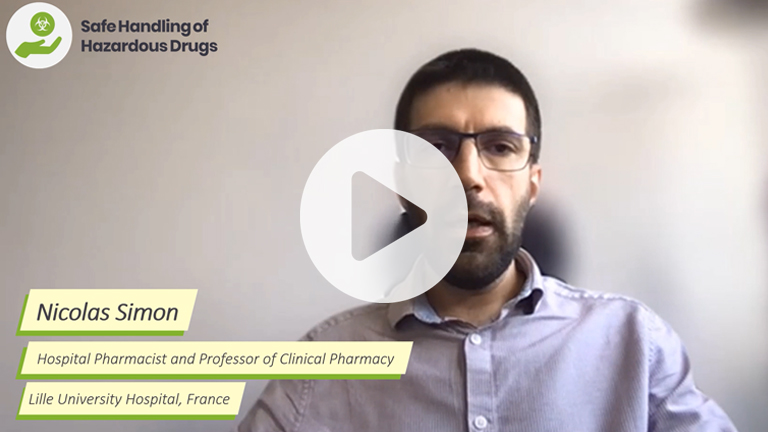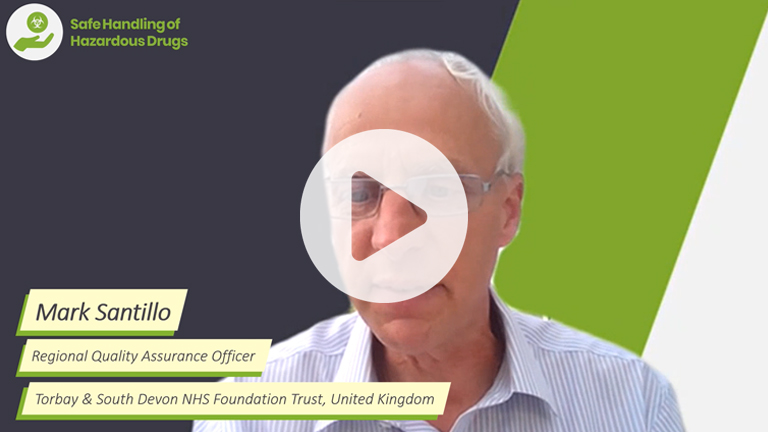OTHER RESOURCES
KEY PAPER EVALUATION
Monitoring contamination of hazardous drug compounding surfaces in hospital pharmaciesINFOGRAPHIC
Summary of the Safe to Touch ConsensusPrecautions, perspectives, and practicalities: the reality of safe handling of hazardous drugs in hospitals
Hazardous drug (HD) surface contamination in healthcare facilities is a concern for individuals involved in all aspects of HD handling.1 Healthcare staff can be exposed to HDs during preparation, transfer and storage, administration, and waste disposal, where inadvertent contamination from leakage and drips spreads throughout the healthcare environment.2 This is not only a risk for nurses who administer HDs, but for all staff and patients.3
No established minimum or safe HD exposure limits exist,5 so healthcare facilities aim to keep surface contamination levels as low as reasonably possible.6 To achieve this, healthcare workers who come into contact with HDs must understand the dangers of surface contamination and carry out the necessary safety precautions. Understanding the experiences and viewpoints of nurses who are involved in the preparation and administration of hazardous drugs can help identify potential barriers to safe handling and encourage reflection on current practices and where improvements could be made.
Several studies have investigated the perspectives of nurses and other healthcare staff on the perceived dangers of hazardous drug handling, and the barriers to reducing surface contamination.
Oncology nurses generally understand that HDs are harmful and many express fears about the health effects of HDs.7 In one survey, 46% of respondents said that they had experienced either headache, dizziness or nausea or a combination of these, 9% experienced hair loss, and over 10% attributed fertility issues to working with HDs.8
Fear about exposure from contamination was associated with higher levels of PPE use,9 however perceived barriers to safety exist amongst nurses. Discomfort while wearing PPE was a shared experience amongst nurses.7,9,10 Common complaints were that gowns were uncomfortable and could cause overheating, and that double gloving of thick chemotherapy gloves restrict movement of nurses’ hands and cause pain.11,10
Nurses doubted their ability to provide compassionate care while wearing full PPE, worrying that it scared, disturbed, and isolated already ill patients.7,10 Nurses on understaffed wards also felt this reduced usage of safety precautions, despite acknowledging the benefits of them and the dangers of HD exposure.8,10
A key theme across many studies was the influence of colleague’s attitudes towards HD safe handling,11 nurses were more likely to engage positively with safety precautions when their peers did, so a positive overall workplace attitude to safe HD handling was key.12
While it is clear that nurses are aware of the dangers of HD exposure and try to limit surface contamination through safety precautions such as PPE use as much as possible, barriers arise from concern for the comfort of their patients, and periods of high workflow.
References
1. Gabay M, Johnson P, Fanikos, et al. Report on 2020 Safe to Touch Consensus Conference on Hazardous Drug Surface Contamination. Am J Health Syst Pharm. (2021) 78(17):1568-1575.
2. Connor TH, MacKenzie BA, DeBord DG. NIOSH list of antineoplastic and other hazardous drugs in healthcare settings. S. Department of Health and Human Services, Centers for Disease Control and Prevention, National Institute for Occupational Safety and Health (2016). Publication number 2016-161.
3. Eisenberg, S. Closed safety system for administration (CSSA): proposal for a new cytotoxic chemotherapy acronym. BJN (2020) 31:10
4. Astrakianakis G, Jeronimo M, Griffiths A et al. The application of novel field measurement and field evaluation protocols for assessing health care workers’ exposure risk to antineoplastic drugs. J Occup Environ Hyg. (2020) 17(9):373-382.
5. Hodson L, Oveson J, Couch J et al. Managing hazardous drug exposures: information for healthcare settings. S. Department of Health and Human Services, Centers for Disease Control and Prevention, National Institute for Occupational Safety and Health (2020).
6. Valero-García S, González-Haba E, Gorgas-Torner MQ, et al. Monitoring contamination of hazardous drug compounding surfaces at hospital pharmacy departments. A consensus Statement. Practice guidelines of the Spanish Society of Hospital Pharmacists (SEFH). Farm Hosp. (2021) 11;45(2):96-107.
7. Polovich M A (2017) Attitude Shift: Making Safe Handling of Hazardous Drugs a Priority. Oncology Nursing News. 12:2.
8. Simons A (2017). Perceived adverse effects from handling systemic anti-cancer therapy agents. BJN. 26:16.
9. Polovich M.Nurses Use of Hazardous Drug Safe Handling Precautions. Nursing Dissertations, Georgia State University (2010)
10. Topçu S, Beşer A. Oncology nurses’ perspectives on safe handling precautions: a qualitative study. Contemp Nurse. (2017) 53(3):271-283.
11. Menonna-Quinn D, Polovich M, Marshall B. Personal Protective Equipment: Evaluating Usage Among Inpatient and Outpatient Oncology Nurses. Clin J Oncol Nurs. 2019 23(3):260-265.
12. Callahan A, Ames NJ, Manning ML (et al) Factors Influencing Nurses’ Use of Hazardous Drug Safe-Handling Precautions. Oncol Nurs Forum. (2016) 43(3):342-9.
Want to learn more about surface contamination?
Check out these learning modules
Safe preparation and administration of hazardous drugs >
Restricted content
Dr Nicolas Simon introduces his updated module which delves into the problem of decontaminating antineoplastic drug compounding facilities.
Restricted content
Mark Santillo answers key questions on what constitutes acceptable hazardous drug risk assessment and highlights the most common failing. Watch the intro video or go direct to the module!

